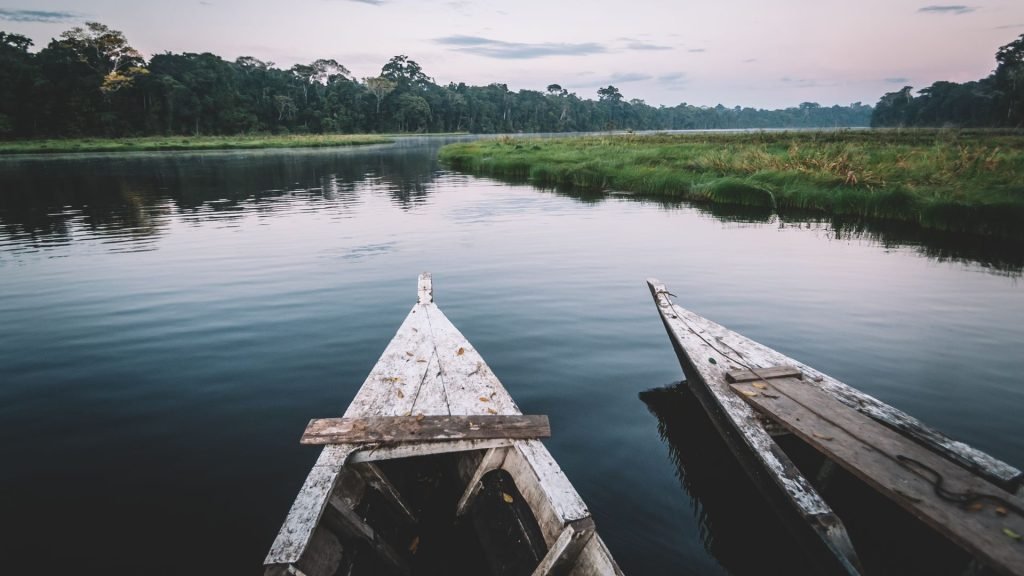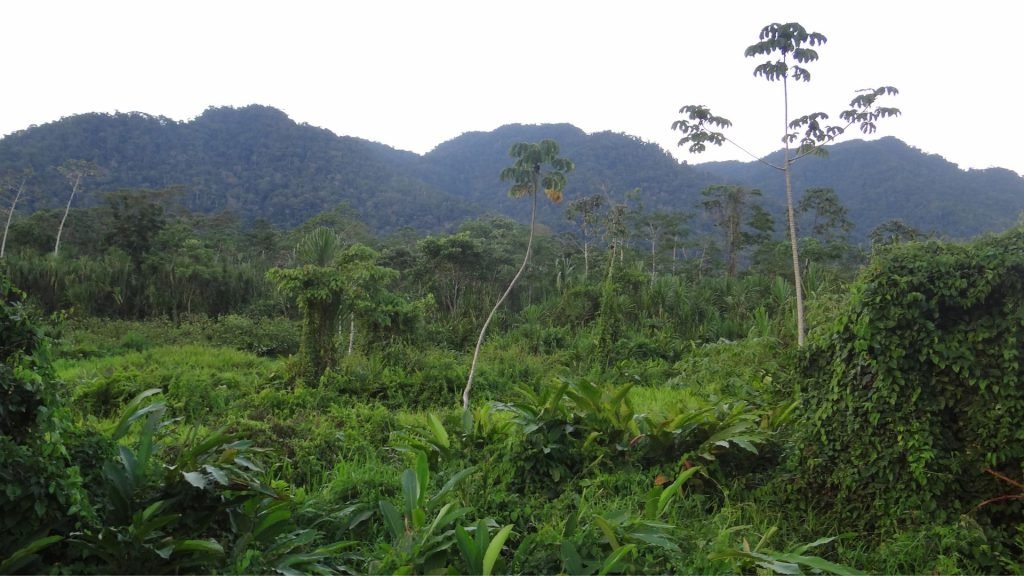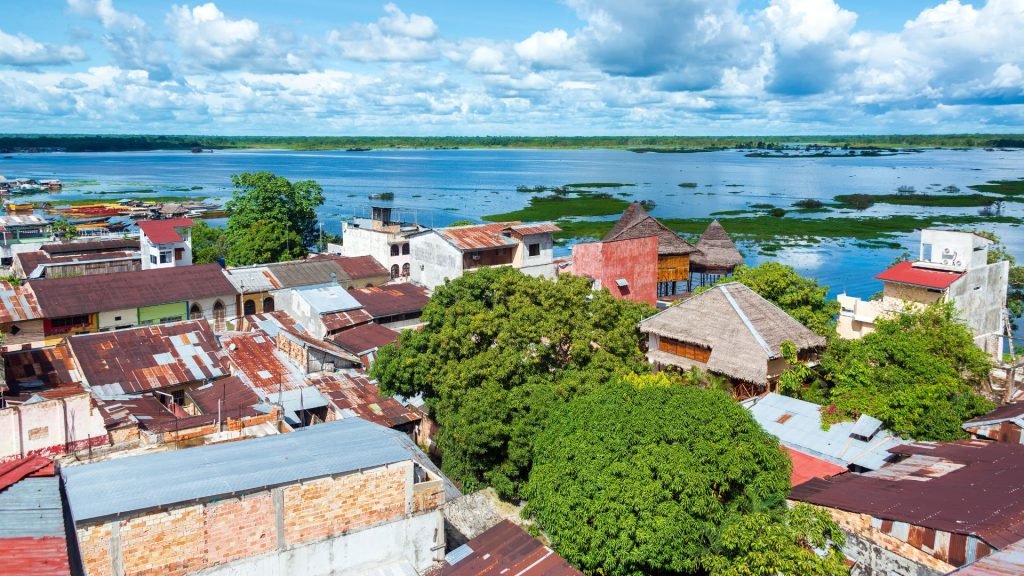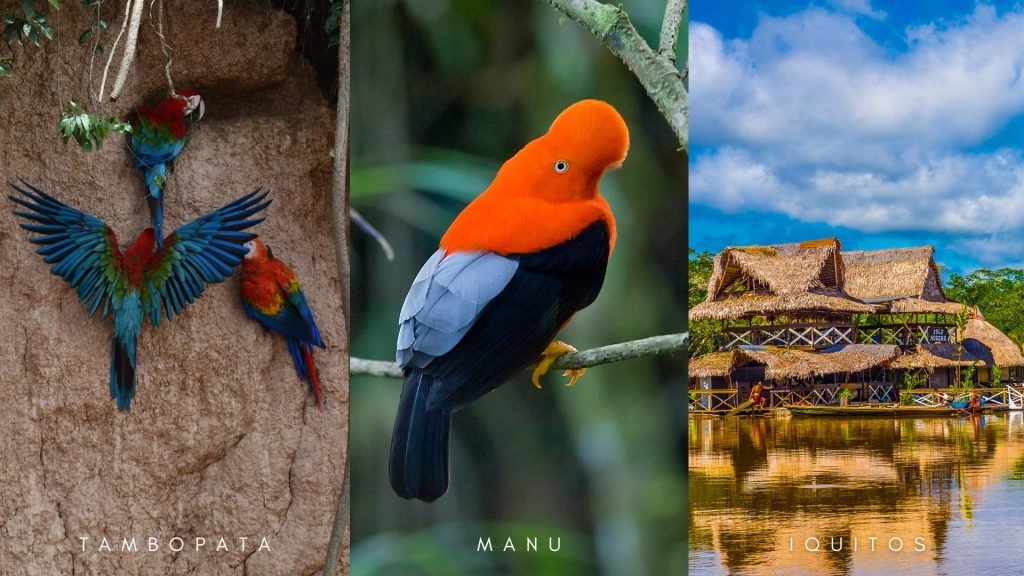If you are doubting which is the best Amazon destination in Peru for your visit, don’t go away and continue reading this article where we will give you the necessary guidelines so you can choose the Amazon destination that best suits your needs.
First of all, all three destinations are a great option if you are looking to see a lot of colorful birds. Otherwise, the cost-benefit analysis of accessibility versus the nature/wildlife you will be able to observe is not enough. Regardless of each of these destinations, there are places where you will have to travel farther and farther to get to observe lower quality wildlife/nature than in Tambopata. So, let’s stick with our original question. And we will answer this question with our analysis based on two dimensions that are the main ones when looking to decide between these Amazon destinations: access vs. nature.
Before we begin, you should know that each destination has a well-developed service offering. What this means is that you will find tourism and lodging services ranging from family homes with a warm welcome but no running water to some of the most exclusive, comfortable and luxurious wilderness experiences in the world.
Tambopata and the Puerto Maldonado area
In our analysis we found three fundamental reasons why you should travel to Tambopata:
- You want a good to great nature and wildlife experience.
- You want to see the world famous Macaw Clay Lick featured in National Geographic, BBC, etc.
- You don’t have much time to spend days in the jungle. The gradient from good to great for nature and wildlife depends on your time. If you have four days (or more) you will have a great experience. If not, you will have a good one.
Access to Tambopata

For this point we group two Trip Advisor destinations (also Lonely Planet, and Rough Guide, etc) in this section: Tambopata and Puerto Maldonado. They are really the same from the perspective of accessibility to the area. To get to both, you have to fly to Puerto Aldamiz airport from Cuzco or Lima. You will find daily flights (LATAM, Sky Airline) just 30 minutes from Cuzco or 1.5 hours from Lima. Once in Puerto Maldonado, all lodges are accessible via the Tambopata River. The closest one (Reserva Amazónica) is 30 minutes away.
The farthest (Tambopata Research Center) is 7 hours away (accessible now by a 3.5 hour drive). Your main concern at this point should be: do I stay near Tambopata National Reserve? And near means IN or AROUND the Tambopata National Reserve. If so, you will get to see a great deal of wildlife. If not, the quality of the nature and wildlife experience will be lower, not necessarily bad but compared to experiences closer to the reserve it will be much poorer.
So, in terms of accessibility: first, check if your lodging is next to (i.e. on the same side of the river as) the Tambopata National Reserve. Second, try to get four (or more) days of availability to visit Tambopata. More days means more opportunities for wildlife viewing and more time to get into the Reserve.
Tambopata Nature and Wildlife
The nature and wildlife in Tambopata is also a strong feature for choosing this destination. The reserve has been protected since 1990. Before that date it was too difficult to access it, so it suffered little threats from hunting, fishing or logging. On a three-day trip to the Tambopata National Reserve you can observe between 3 and 5 species of monkeys (howler, brown capuchin, dusky marmoset, tamarin and squirrel monkey), agoutis and capybaras (the world’s largest rodent), white caimans, giant river otters (if you visit a oxbow lake) and dozens of bird species, and if you are very lucky you may even catch a glimpse of jaguars.
Don’t forget grasshoppers, scorpion wasps, dung beetles, army ants, tiger moths and millions (literally) of insect species. You may even discover some new species. A four-day (or longer) trip will take you into the heart of the reserve and add the world-famous macaw clay licks, a 40% chance of seeing jaguars (depending on the season), spider monkeys and herds of a hundred white-lipped peccaries. It is hard to believe that just one extra day makes a difference. The reason is the “defaunation shadow” which we will talk about next. In Tambopata / Puerto Maldonado the shadow reaches the border of the reserve and then stops. On that extra day: you cross it.
Manu National Park and the Cloud Forest Highway

There are two main reasons to go to Manu:
- You are a birdwatcher.
- You have plenty of time for a long visit (a week or more).
You should know that if you hate bumpy roads or small airplanes (twin-engine and similar) this is not a good option for you. Extra reason: you will have the opportunity to meet the Machiguenga community.
Nature and wildlife in Manu
Manu is one of the two reserves that are always in mind when talking about protected areas in the Amazon that are open to tourism. The other is Tambopata, which we have already discussed previously. You will not find similar nature tourism experiences in the Amazon. Like Tambopata, Manu was declared a National Park in 1974, before agriculture, logging and hunting devoured it. Steep mountain ranges with impenetrable cloud forests protect it from squatters and loggers.
One of the few Amazonian destinations with vast tracts of accessible cloud forest. Unlike Tambopata, Manu’s cloud forest is relatively easy to access by road. Therefore, if you visit Manu, you will get the same as in Tambopata plus the cloud forest. This area is important because you will be able to observe woolly monkeys and cock of the rock. And you will add more than a hundred species of flycatchers, antbirds, tanagers and hummingbirds to your bird list. So if you like birds, Manu is your first choice. However, if you are not a big fan of them, the cons outweigh the pros.
Access to Manu
Going straight to the grain to get to Manu is difficult. The Manu road starts in Cusco and goes up and down through two mountain ranges. The trip is long (8-10 hours in the dry season) and full of potholes in the road. It is not recommended in the rainy season (November to March), as you could get stuck waiting for a mudslide to clear. Once in the lowlands, the boat ride can take anywhere from 4 to 10 hours, depending on the destination. And don’t forget the way back. Charter planes can get you to the lowlands in a heartbeat, so ask your operator for availability and pricing. One year they’re there, the next year they’re not, so keep an eye out if you opt for this transport.
In summary, repeating what we said at the beginning: if you have time for a one-week expedition to the Manu area and you do not mind getting a little complicated in the journey to get to the Manu area, you can opt for this option.
And don’t forget our extra reason: To meet the Machiguenga people. In the last 15 years, the Machiguenga communities have opened up to tourism with the opening of lodges. Check out Casa Machiguenga and Pankotsi Manu Lodge. If you don’t mind the modest lodging and food services, you will learn a lot from the friendly and fun Machiguenga, definitely an extra reason to consider if you enjoy experiential tourism.
Iquitos and the Amazon River

There are three main reasons to go to Iquitos.
- You want to see the Amazon River.
- You want to take a boat cruise.
- You want to experience the Amazonian riverine culture.
If you are looking for nature and wildlife, you should opt for the previous options, Tambopata or Manu.
Access to Iquitos and the Amazon River
Iquitos and the Amazon River are easily accessible from Lima. You will find daily flights (from Latam, Star Peru, Sky Airlines and Viva Air). Direct flights take two hours. Once in Iquitos, you will have to head to the malecon. There it is, the Amazon River, the largest and longest in the world. To fully enjoy the Amazon River, you have to go a little further. Do this by booking a trip with any of the lodges or operators that offer their services in the area, you can even take a cruise through the Amazon River.
Nature and wildlife in Iquitos and the Amazon River
Iquitos is an incredible city with no road connection to the rest of the world. As a result, its 450,000 inhabitants consume only those products that arrive by boat or plane or that they can harvest from the jungle through agriculture, gathering, fishing and hunting. And therein lies the problem. Four hundred thousand people in the middle of the jungle using chainsaws, fertilizers, shotguns and fishing nets cast an enormous shadow. A recent study in Manaus, Brazil (population 2 million) found that it had a “defaunation shadow” of 1,000 kilometers!
In other words, within 1000 kilometers around Manaus, wildlife is affected by human activities such as hunting, fishing, logging, etc. By the way, the fact that Iquitos has 400,000 inhabitants means that it is the best place to experience today’s Amazonian riverine culture. As soon as you get off the plane, you’ll smell the street vendors selling macambo and aguaje, the local tropical crops. Visit the market and you’ll see fresh carachama fish and bush meat, many of the foods you’ll eat in Iquitos are prepared from local crops.
Pacaya Samiria National Reserve and Alpahuayo Mishana Natural Reserve
This does not mean that Iquitos has no solution to its “shadow of defaunation”. On the contrary, if you want to see Amazonian wildlife and nature in good condition you will have to take an extra week to visit El Dorado in the Pacaya Samiria National Reserve. Or a watery nature experience may suffice: visit the Alpahuayo Mishana Nature Reserve, 20 kilometers from Iquitos, to spot small endemic antbirds and small monkeys. And you can even invest a little more budget in one of Peru’s 5 most luxurious experiences on the Aqua or El Delfin cruises through the Amazon River. You will enjoy one of the best dinners in Peru and pink river dolphins.





